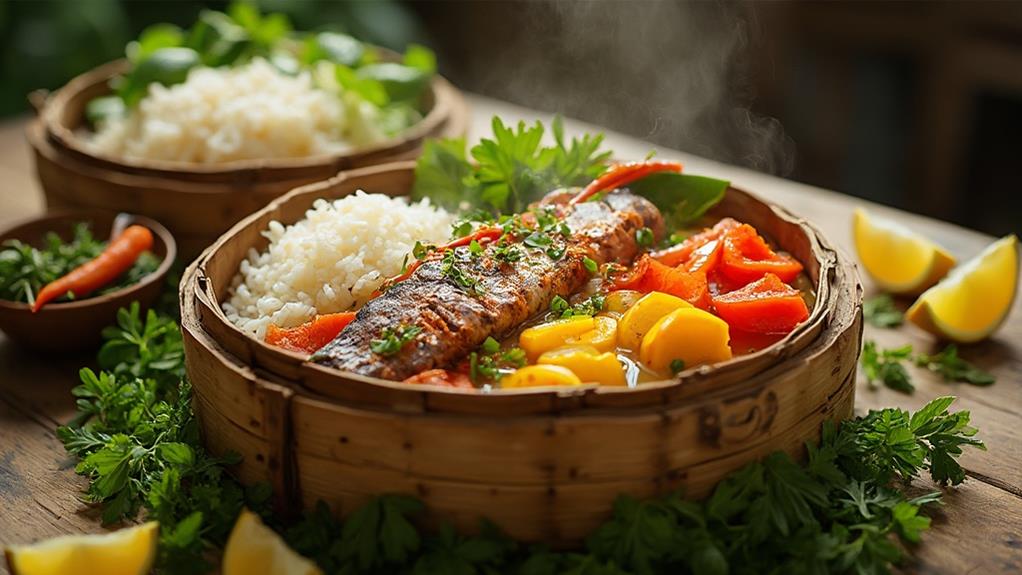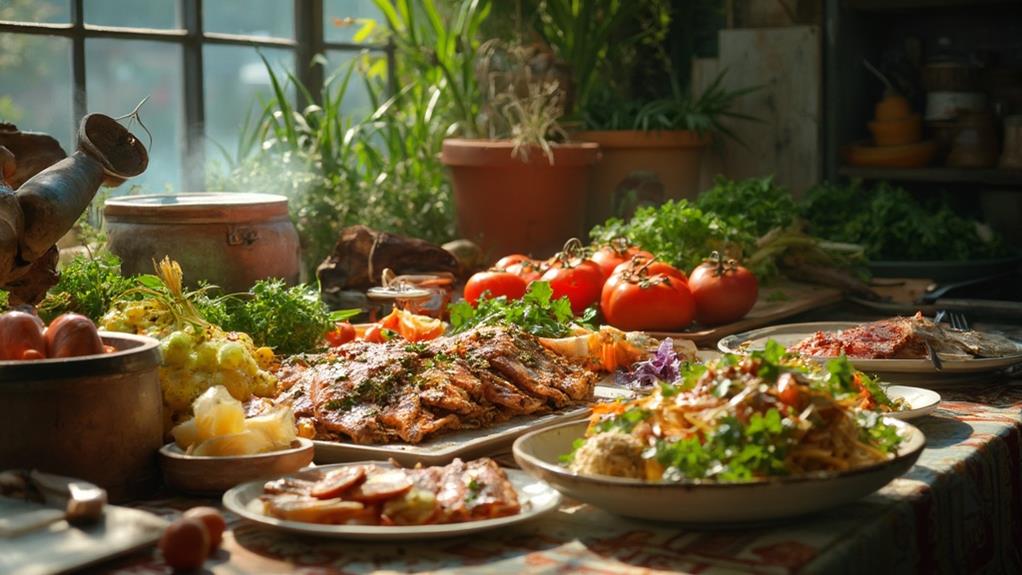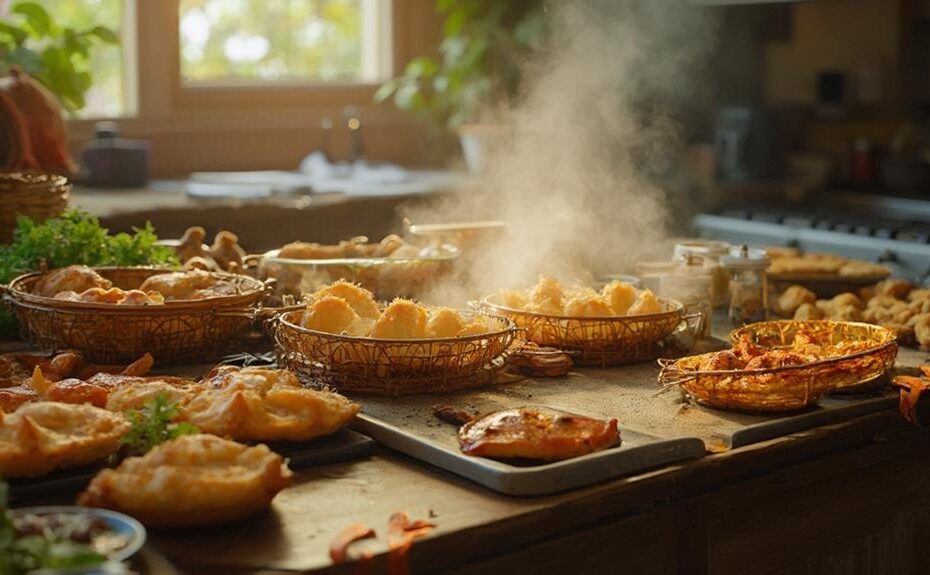Healthy Cooking Methods for Filipino Dishes
Baking: A Healthier Alternative
Baking reduces the need for excess oil while enhancing flavors in Filipino dishes.
Using whole grain flour and natural sweeteners in baked goods not only lowers calorie intake but also adds more nutrients and fiber to the meal.
Steaming: Preserving Nutrients and Flavor
Steaming is a cooking method that locks in essential nutrients and flavors, keeping vegetables vibrant and full of vitamins.
This method helps retain the natural goodness of ingredients, making steamed dishes a healthy and flavorful option.
Grilling: Flavorful and Fat-Reducing
Grilling not only gives meals a smoky flavor but also allows fats to drain away, aiding in calorie reduction.
By grilling meats and vegetables, you can enjoy a flavorful and healthier version of your favorite Filipino dishes.
Elevating Taste with Fresh Herbs
Incorporating fresh herbs into your cooking can elevate the taste of meals without adding extra calories.
This simple trick can make a big difference in the flavor and nutritional value of your Filipino dishes.
Benefits of Healthy Cooking
Healthy cooking methods preserve nutrients and promote overall well-being. Cooking techniques like steaming, grilling, and sautéing retain more nutrients than frying, ensuring you get the most out of your ingredients.
For example, steaming vegetables retains vitamins like C and B, which are often lost in traditional frying methods.
Healthy cooking methods can lower your calorie intake. By minimizing the use of oils and fats, you reduce excess calories while still enjoying the rich flavors of Filipino cuisine.
Grilling, for example, allows fats to drip away from the food, which can help with weight management.
Healthier cooking fosters creativity in the kitchen. Experimenting with spices and fresh herbs can enhance flavors without adding extra calories or sodium, making your meals both nutritious and delicious.
Using fresh herbs like parsley and basil can add flavor to dishes without adding extra salt or sugar.
Cooking healthily can also be more economical. You may find that using fresh, whole ingredients not only boosts your health but also saves you money in the long run.
Baking Filipino Classics
Baking Filipino Classics: A Healthier Twist on Traditional Flavors
Baking Filipino classics offers a delicious way to enjoy traditional flavors while embracing healthier cooking methods. This technique reduces the need for excess oil and allows for a variety of textures and flavors to shine through. The intricate patterns and colors of Philippine weaving traditions, such as Tboli pis syabit, have inspired many Filipino dishes, which can now be baked in a healthier way.
Retaining Essential Ingredients and Minimizing Unhealthy Fats
When you bake dishes like bibingka or puto, you retain the essential ingredients while minimizing unhealthy fats. For instance, using whole grain flour adds fiber and nutrients without sacrificing taste. You can also experiment with natural sweeteners, replacing refined sugar in lechon belly or mamon recipes, which can help lower calorie counts.
Controlling Portions and Adding Nutrition
Baking allows you to control the portions better by making smaller batches or individual servings, satisfying your cravings without overindulging.
You can also incorporate vegetables into your baked goods, such as adding grated carrots or zucchini to carrot cake for added nutrition.
Mastering the Art of Baking Filipino Classics
It's essential to preheat your oven and monitor the baking times to achieve the perfect texture.
With practice, you'll master the art of baking Filipino classics that maintain the cultural essence while promoting a healthier lifestyle. Embrace these methods, and you'll find joy in savoring both tradition and health.
How Can Baking, Steaming, and Grilling Contribute to a Balanced Diet in Filipino Cuisine?
Baking, steaming, and grilling are popular cooking methods in Filipino cuisine that can promote the importance of balanced diet. These methods involve less oil and retain more nutrients in the food, making them healthier options. By incorporating these cooking techniques, Filipino cuisine can offer a variety of nutritious and well-balanced meals.
Steaming for Flavor and Nutrition

Steaming: A Healthy Cooking Method for Filipino Dishes
Steaming is an excellent cooking technique that preserves the natural flavor and nutrients of ingredients in Filipino dishes. Unlike frying or boiling, steaming retains the natural moisture and nutrients of vegetables like kangkong (water spinach) and sitaw (string beans), preserving their vibrant color and crisp texture.
This method also locks in essential vitamins and minerals, such as vitamin C and iron.
Improved Physical Fitness and Mental Health
Steaming can even contribute to improved physical fitness by allowing you to prepare healthy meals that support overall well-being. Moreover, it can reduce stress and anxiety, promoting mental health benefits.
Easy and Versatile Cooking
Using a steamer basket or a bamboo steamer, you can cook dishes like puto (steamed rice cakes) or siomai (dumplings) without adding unhealthy fats.
The gentle heat intensifies the flavors of your ingredients, allowing you to enjoy the natural tastes without overwhelming them with oils or heavy sauces.
Steaming is incredibly versatile, making it easy to adapt traditional recipes to this method and ensure your meals are both delicious and nutritious.
Discover the Benefits of Steaming
By incorporating steaming into your cooking routine, you'll discover a way to prepare Filipino classics that aligns with a healthier lifestyle.
Give steaming a try and experience the benefits for yourself!
Grilling Techniques for Filipino Dishes
Grilling Techniques for Filipino Dishes
Grilling is an excellent way to enhance the flavors of traditional Filipino dishes while keeping them healthy. This cooking method caramelizes natural sugars and allows excess fats to drip away, reducing calorie intake.
Direct Grilling
Direct grilling involves placing food directly over the heat source. This technique is ideal for dishes like Inihaw na Liempo (grilled pork belly), where a crispy exterior and smoky flavor are desired.
Indirect Grilling
Indirect grilling involves placing food away from the heat source. This technique is suitable for dishes like Lechon Manok (roast chicken), where slow cooking is necessary to achieve tender meat.
Skewering
Skewering involves threading food onto skewers before grilling. This technique is perfect for BBQ skewers (pork or chicken), allowing for even cooking and easy serving.
Marinating
Marinating involves soaking food in a mixture of seasonings and acids before grilling. This technique is essential for dishes like Adobo-style marinated meats, where the marinade infuses flavor and tenderizes the meat.
Grilling Vegetables
Grilling vegetables adds smoky flavor and texture to dishes. This technique is ideal for Ensaladang Mangga (green mango salad), where grilled vegetables complement the tangy mango.
Grilling Tips
When grilling, marinate meats several hours in advance to infuse them with flavor. Use traditional Filipino ingredients like soy sauce, vinegar, and calamansi for authentic taste.
Preheat the grill to achieve beautiful grill marks while sealing in moisture. Finally, add vegetables alongside meats for a well-rounded meal.
Tips for Healthier Cooking

Healthier Cooking Starts with Ingredient Choices
When it comes to healthier cooking, the ingredients you choose can make a significant difference in the nutritional value of your meals. Opt for fresh, whole ingredients like local vegetables and lean meats, which are packed with nutrients and lower in unhealthy fats.
Incorporate whole grains like brown rice or quinoa to increase fiber content and improve digestion.
Cooking Techniques Matter
The way you cook your food can also impact its nutritional value. Instead of frying, try baking or steaming your dishes. Baking retains natural flavors without adding excess oil, while steaming preserves nutrients that can be lost during boiling.
Use marinades made from vinegar and herbs when grilling to enhance flavors without the need for heavy sauces.
Portion Control and Seasoning
Use smaller plates to manage servings better and avoid overindulging in your favorite dishes.
Be mindful of salt and sugar and experiment with herbs and spices to season your meals, which can elevate flavors without adding extra calories.
